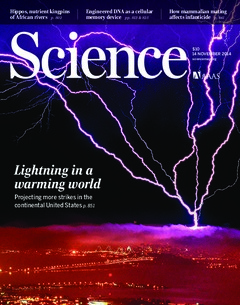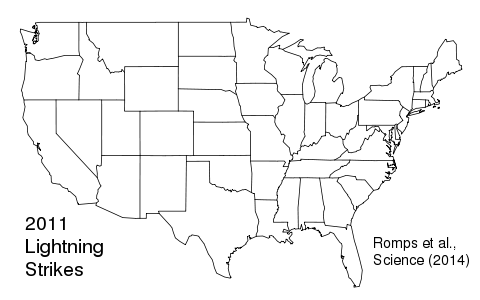Romps, Seeley, Vollaro, and Molinari, Projected increase in lightning strikes in the United States due to global warming, Science, 2014
Television coverage
Inside Science
Radio coverage
KGO 810
KPCC 89.3
KCBS 106.9
KUHF 88.7
Paper
Description
The image on the cover of Science was photographed a short walk from the UC Berkeley Department of Earth and Planetary Science. Note Berkeley in the foreground.

Lightning strikes during June, July, and August of 2011 as measured by the National Lightning Detection Network. In this animation, each day takes exactly 1 second; note how the amount of lightning tends to pulse with the daily cycle of solar heating. Click here for an MP4 of a movie of lightning during all of 2011.

Lightning plays an important role in atmospheric chemistry and in the initiation of wildfires, but the impact of global warming on lightning rates is poorly constrained. Here, we propose that the lightning flash rate is proportional to the convective available potential energy (CAPE; a measure of how explosively clouds can rise) times the precipitation rate. Using three independent observational data sets (one for CAPE, one for precipitation, and one for lightning), the product of CAPE and precipitation explains 77% of the variance in the time series of total cloud-to-ground lightning flashes over the contiguous United States (CONUS). The figure above shows an animation of the lightning data during June, July, and August of the year studied.
With version 5 of the Coupled Model Intercomparison Project (CMIP5), modeling groups have saved the fields that are needed to calculate CAPE. This makes it possible to use this "CAPE times precipitation" proxy to study future changes of lightning. Here, we used output from all 11 models in the CMIP5 archive that had saved the required output. Using a business-as-usual global-warming scenario (RCP8.5), CONUS lightning strikes increase by about 50% over the 21st century.